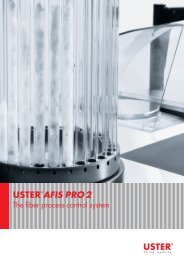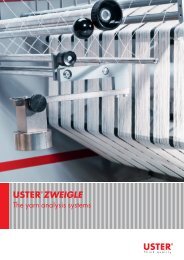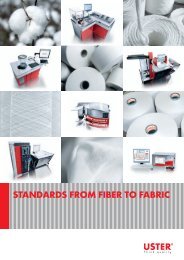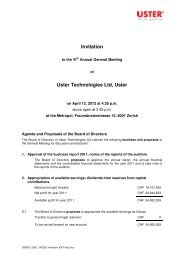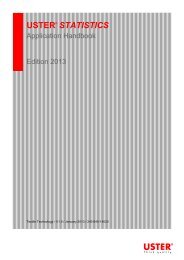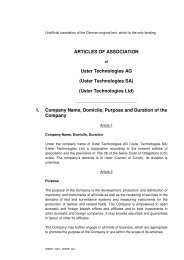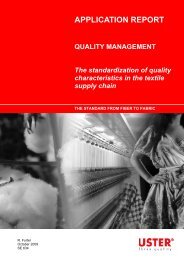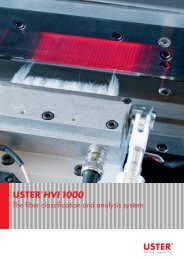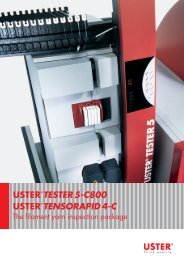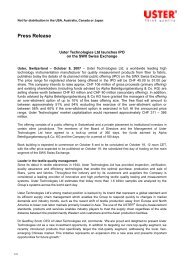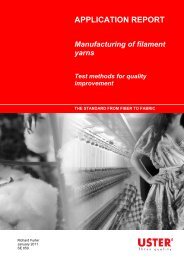Operational ReviewOperativer Rückblick<strong>Uster</strong> <strong>Technologies</strong> <strong>Ltd</strong> looks back on a year in whichthe rapid decline in the textile industry reached thebottom and sales stabilized at a significantly lowerlevel. The entire textile industry value chain sufferedfrom declining consumer spending. The knock-oneffects included lower sales of new clothes, furnishingand other textile fabrics. Consequently demand forraw materials and textile machinery declined togetherwith a reduction in investment appetite from customers.However, there were some positive economic indicators,predominantly in the second half of the year, thatsignaled a recovery of general market conditions. Animportant factor was the slight improvement in financingconditions for new investments in all majormarkets as the pressure on international financialmarkets eased. Furthermore demand for new yarnproduction picked up after producers reduced excessyarn stocks in the initial months of the year, rekindlinginterest in measuring system investments asthe demand for quality remains a key priority fortextile manufacturers in order to secure and growtheir businesses.At the same time reduced cotton prices combinedwith renewed demand for yarn resulted in an improvementin margins for yarn producers, the so-calledconversion margin, encouraging them to plan newinvestments in quality improvements – commitmentsthat had been postponed until the markets showedsigns of revitalization.Lastly, attention is drawn to the stable developmentof the important Chinese market. Thanks to the minimalexposure of the Chinese financial system to thesubprime crisis and well-directed government stimuluspackages, textile manufacturers in China continuedto invest in sustainable quality improvements,albeit not as much as in previous years.Strong Margins MaintainedDespite the challenging market environment in the<strong>2009</strong> financial year <strong>Uster</strong> <strong>Technologies</strong> <strong>Ltd</strong> deliveredstrong margins on a reduced sales level. Gross salesdeclined to CHF 100.8 million (2008: CHF 154.9 million)whilst the Group reached an EBITA of CHF 22.7 million<strong>Uster</strong> <strong>Technologies</strong> AG blickt auf ein Jahr zurück, indem der massive Geschäftsrückgang in der Textilindustrieseinen Tiefpunkt erreichte und sich der Umsatzauf deutlich niedrigerem Niveau stabilisierte. Diegesamte Textilindustrie wurde durch rückläufigeKonsumentenausgaben belastet. Dies schlug sich ineinem Umsatzrückgang bei neuer Kleidung, textilerWohneinrichtung und anderen Textilprodukten nieder.Demzufolge sank die Nachfrage nach Rohstoffenund Textilmaschinen parallel zur abnehmenden Investitionsbereitschaftder Kunden.Es gab aber auch – vor allem im zweiten Halbjahr –positive Zeichen, die auf eine konjunkturelle Erholungder allgemeinen Marktlage hindeuteten. Ein wichtigerFaktor war die leichte Verbesserung der Finanzierungsbedingungenfür Neuinvestitionen in allengrossen Märkten sowie der nachlassende Druck an deninternationalen Finanzmärkten. Ferner erhöhte sichdie Nachfrage nach der Produktion von neuem Garn,nachdem die Hersteller ihre Überbestände an Garn inden ersten Monaten des Jahres reduziert hatten. Diesführte zu einer Wiederbelebung des Interesses an Prüfsystemen,denn erstklassige Qualität ist und bleibt fürTextilhersteller eine Priorität – sie bildet die Voraussetzung,um die eigene Wettbewerbsposition zu haltenund auszubauen.Zudem wirkten sich die rückläufigen Baumwollpreisezusammen mit der neuen Nachfrage nach Garnpositiv auf die Margen der Garnhersteller, die so genanntenConversion-Margen, aus und veranlasste sie,neue Investitionen in Qualitätsverbesserungen zuplanen – Vorhaben, die aufgeschoben worden waren,bis die Märkte Anzeichen einer Erholung zeigten.Schliesslich entwickelte sich der wichtige chinesischeMarkt relativ stabil. Dank der minimalen Beeinträchtigungdes chinesischen Finanzsystems durch dieSubprime-Krise und gezielter staatlicher Förderprogrammeinvestierten die Textilhersteller in Chinaweiter in nachhaltige Qualitätsverbesserungen, wenngleichauf niedrigerem Niveau als in früheren Jahren.Weiterhin starke MargenTrotz des schwierigen Marktumfelds erzielte <strong>Uster</strong><strong>Technologies</strong> AG im Geschäftsjahr <strong>2009</strong> bei niedrige-8 <strong>Uster</strong> <strong>Technologies</strong> <strong>Ltd</strong> | <strong>Annual</strong> <strong>Report</strong> <strong>2009</strong>
(2008: CHF 34.2 million) keeping the margin at a stronglevel of 22.5% (2008: 22.1%). The net result amountedto CHF 1.1 million (2008: CHF 5.3 million).Stable Offline, Improving Online BusinessIn <strong>2009</strong> the cotton classing business, which is fundedby governments, and the yarn clearer business,which was driven by renewed demand for yarn, developedpositively, recovering from the low levelswhich were seen in the fourth quarter of 2008 and thefirst quarter of <strong>2009</strong>. The pleasing development inboth business areas was mainly driven by the resilienceof the Chinese textile industry to the general marketdownturn as Chinese textile producers continue tofocus on quality improvements.In the cotton classing business the Company maintainedits strong relationship with the China FiberInspection Bureau (CFIB). To fulfill their ongoingexpansion plans and to complete the current five yearproject plan, CFIB placed high levels of orders forUSTER ® HVI cotton classing systems, resulting in thelargest classing project ever handled by our Company.In parallel the <strong>Uster</strong> Group delivered a number ofclassing systems to the United States Department ofAgriculture (USDA) as part of the agency’s replacementprogram for its offices throughout the cottongrowing regions in the US. Additional business forthe HVI cotton classing systems was secured in othercotton growing regions including India, Africa andCentral Asia. As cotton prices began to increase inrecent months, manufacturers are again focusing onquality differentiation.In the laboratory yarn and fiber testing business theGroup’s revenues were impacted by slow business inIndia, Turkey and Pakistan whereas sales in Chinaremained relatively stable, although at lower levels.The number of new projects and mill expansions alsodeclined world-wide in <strong>2009</strong>. However, the focus ofmany textile manufacturers shifted towards efficiencyimprovements and cost reductions to ensurehigh quality, resulting in new demand for USTER ®laboratory systems. Thanks to the acquisition of theproduct range of Zweigle the <strong>Uster</strong> Group successfullycomplemented and further strengthened itsren Umsätzen hohe Margen. Bei einem Rückgang desBruttoumsatzes auf CHF 100.8 Mio. (2008: CHF 154.9 Mio.)erwirtschaftete die Gruppe ein EBITA von CHF 22.7 Mio.(2008: CHF 34.2 Mio.) und hielt die Marge mit 22.5%(2008: 22.1%) auf hohem Niveau.Trotz des äusserstschwierigen Markumfeldes betrug das Nettoergebnispositive CHF 1.1 Mio. (2008: CHF 5.3 Mio.).Stabiles Offline-, besseres Online-GeschäftDie Geschäfte mit der von staatlicher Seite finanziertenBaumwollklassierung und mit Garnreinigernentwickelten sich im Geschäftsjahr <strong>2009</strong>, ausgelöstdurch die wiederbelebte Nachfrage nach Garn, positivund erholten sich von den Tiefständen im viertenQuartal 2008 und ersten Quartal <strong>2009</strong>. Die erfreulicheEntwicklung in beiden Geschäftsbereichen gründeteprimär auf der vergleichsweise robusten chinesischenTextilindustrie, umso mehr als die chinesischen Textilherstellerweiter auf Qualitätsverbesserungen setzen.Im Baumwollklassierungsgeschäft gelang es demUnternehmen, seine enge Beziehung zum chinesischenAmt für Faserprüfung (CFIB) aufrechtzuerhalten. ZurUmsetzung laufender Expansionspläne und Erfüllungdes aktuellen Fünfjahres-Projektplans bestellte dasCFIB eine grosse Anzahl neuer USTER ® HVI-Baumwollklassierungssysteme.Es handelte sich um das grössteKlassierungsprojekt, das von <strong>Uster</strong> <strong>Technologies</strong> AGje abgewickelt wurde. Gleichzeitig lieferte die <strong>Uster</strong>-Gruppe im Rahmen des laufenden Erneuerungsprogrammssämtlicher Prüfstellen innerhalb derBaumwollregionen der Vereinigten Staaten weitereKlassierungssysteme an das US-Landwirtschaftsministerium(USDA). Darüber hinaus erhielt <strong>Uster</strong> <strong>Technologies</strong>AG neue Aufträge für Baumwollklassierungssystemeaus anderen Baumwollregionen wieIndien, Afrika und Mittelasien. Da die Baumwollpreisein den letzten Monaten erneut gestiegen sind,setzen die Hersteller wieder vermehrt auf Qualität alsDifferenzierungsmerkmal.Bei den Garn- und Faserprüfsystemen für Textillaborsbeeinträchtigte das schwache Geschäft in Indien, derTürkei und Pakistan den Konzernumsatz. Parallel dazublieben die Umsätze in China relativ stabil, wenngleichauch auf niedrigerem Niveau. Die Anzahl neuer Pro-Operational Review | Operativer Rückblick 9
- Page 1 and 2: Uster Technologies Ltd | Annual Rep
- Page 3 and 4: Achievements 2009• EBITA margin m
- Page 5: PortraitThe Uster Group is the lead
- Page 8 and 9: Table of ContentsInhaltsverzeichnis
- Page 10 and 11: Max-Ulrich Zellweger, Geoffrey Scot
- Page 12 and 13: Quality means the customercomes bac
- Page 16 and 17: Inconsistent quality meansloss of p
- Page 18 and 19: position as the world leader and au
- Page 20 and 21: Poor quality can destroybrand reput
- Page 22 and 23: Sales and MarketingVertrieb und Mar
- Page 24 and 25: The hidden cost of poor qualityThin
- Page 26 and 27: Research and InnovationForschung un
- Page 28 and 29: OperationsProduktion und LogistikIn
- Page 30 and 31: OutlookAusblickSeveral trends and l
- Page 32 and 33: Corporate GovernanceThe information
- Page 34 and 35: • On February 10, 2009, Lombard O
- Page 36 and 37: 2.4 Shares and Participation Certif
- Page 38 and 39: Board of DirectorsMembers of the Bo
- Page 40 and 41: Harald Rönn, Member of the Board o
- Page 42 and 43: The Board of Directors may entrust
- Page 44 and 45: Nomination and Compensation Committ
- Page 46 and 47: Executive CommitteeMembers of the E
- Page 48 and 49: 4 Executive Committee4.1 Members of
- Page 50 and 51: Harold R. Hoke Jr., Head of Sales a
- Page 52 and 53: 6.2 Statutory QuorumsUnless mandato
- Page 54 and 55: 9 Information PolicyUster Technolog
- Page 56 and 57: Comment on the Consolidated Financi
- Page 58 and 59: Uster Group - Consolidated Financia
- Page 60 and 61: Consolidated Statement of Cash Flow
- Page 62 and 63: Consolidated Statement of Changes i
- Page 64 and 65:
2.5 Impairment of Goodwill and Inta
- Page 66 and 67:
Standards, Amendments and Interpret
- Page 68 and 69:
3.4 Intangible AssetsBusiness Combi
- Page 70 and 71:
3.6 Financial InstrumentsFinancial
- Page 72 and 73:
3.7 InventoriesInventories are meas
- Page 74 and 75:
3.13 Revenue RecognitionRevenue fro
- Page 76 and 77:
The carrying amount of financial as
- Page 78 and 79:
The table below sets out the carryi
- Page 80 and 81:
The fair value of the bank loans ha
- Page 82 and 83:
8.4 Personnel Expensein CHF 1,000 J
- Page 84 and 85:
12 Intangible Assetsin CHF 1,000 Cu
- Page 86 and 87:
13 Impairment Testing of Goodwill a
- Page 88 and 89:
14 Property, Plant and Equipmentin
- Page 90 and 91:
The changes in the present value of
- Page 92 and 93:
16 Income TaxStatement of Comprehen
- Page 94 and 95:
Movements in Temporary DifferencesT
- Page 96 and 97:
The ageing of these receivables is
- Page 98 and 99:
21.3 DividendsThe holders of regist
- Page 100 and 101:
Restructuring ProvisionsThe Company
- Page 102 and 103:
26 Operating Lease CommitmentsNon-c
- Page 104 and 105:
Report of the Statutory Auditor on
- Page 106 and 107:
Uster Technologies Ltd - Financial
- Page 108 and 109:
Uster Technologies Ltd - Notes to t
- Page 110 and 111:
10 Investments in SubsidiariesAs of
- Page 112 and 113:
Executive Committeein CHF 2008Name
- Page 114 and 115:
Report of the Statutory Auditor on
- Page 116 and 117:
Information for InvestorsShare Info
- Page 118 and 119:
Key Figuresin CHF 1,000 Jan 1 -Dec
- Page 120 and 121:
in CHF 1,000 2009 2008 2007 2006 1)
- Page 122:
ImprintContent Concept and EditingI



